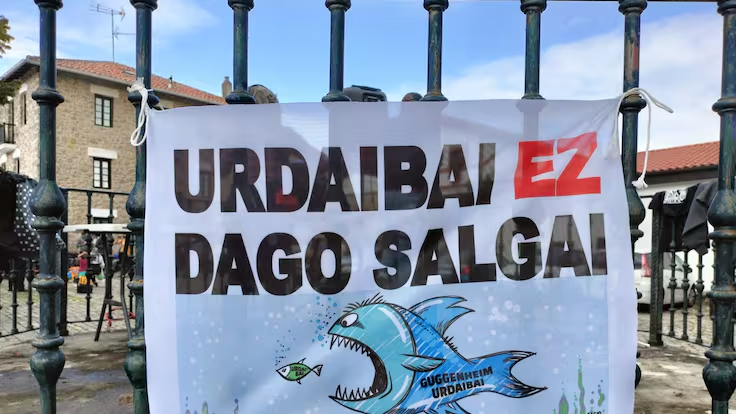The project for the new museum Guggenheim located in the Urdaibai Biosphere Reserve breaches the Coastal Law. This is a project of more than 61,000 m2 in a protected area, the Urdaibai Biosphere Reserve. Denounces the Ministerial Order that reduces the coastal protection easement from 100 to 200 meters. Greenpeace considers it unprecedented that the Ministry of Ecological Transition (MITECO) breach the Coastal Law.
The environmental organization has appeared today in court against the construction project of the two new headquarters of the Guggenheim Museum and Urdaibai when considering that the Coastal Law is being breached. The facilities would be built 20 meters from the Urdaibai marshes, an area protected for its great ecological value that would also be impacted by tourism.
The project proposes building two headquarters, one of them in Astilleros de Murueta, located on land reclaimed from the marsh that enjoys international protection. Furthermore, the ministry of Ministry of Ecological Transition (MITECO) allows the Shipyards evade their responsibility to decontaminate the soil.
For this reason, the environmental organization has today filed a contentious administrative appeal against the Ministerial Order that approves the reduction of the easement for the protection of the public maritime land domain in Murueta. Until the publication of the Ministerial Order, this coastal protection strip was 100 meters, but it has now been reduced to only 20 meters.
The Ministerial Order opens the door to the installation of a project of more than 61,000 m2 in an area that enjoys countless figures of international protection: Urdaibai is declared a Biosphere Reserve; The Oka River estuary is part of the international Ramsar Convention on Wetlands; The Mundaka-Gernika estuary is considered a Wetland of International Importance and Murueta is part of the Natura 2000 Network. All of these figures entail the obligation to maintain a high state of conservation in the area.
The project for the Guggenheim museum ignores all environmental protection figures
- The project is totally unrelated to the defense and protection of the maritime terrestrial public domain, which in itself already leads to the nullity of the Ministerial Order.
- The Administration fails to fulfill its obligation to defend the public maritime terrestrial domain. Despite the undoubted and recognized high ecological value of the area, the Ministry for the Ecological Transition and the Demographic Challenge, agrees to the rectification and reduction of the easement, to install a museum instead of proceeding to protect the maritime terrestrial public domain through of the protection easement and to proceed with the recovery of the lands of the aforementioned domain occupied by shipyards that supposedly have no activity and whose concession must be understood to have expired.
- The Ministerial Order improperly applies article 44.5 of the Coastal Regulation as none of the requirements established by said precept are met, since it would be necessary for there to have been a modification to the affected lands and this is not the case, since the demarcation of The area has been approved since 2004 without any modifications.
“We hope that the ministry will take a step back and withdraw this ministerial order that violates the Coastal Law. Urdaibai It has the same environmental value as Doñana, and deserves to have its protection respected. Furthermore, we have little coast left in such an exceptional state of conservation. The administrations and the justice system must protect it just like us,” declared Lorea Flores, spokesperson for the environmental organization in Euskadi.
For all these reasons, the environmental organization has filed the contentious-administrative appeal since it understands that the ministerial order that is the subject of the procedure incurs the cases of nullity by operation of law of sections a), e), f) and g) of article 47 of the Law 39/2015 on the Common Administrative Procedure of Public Administrations.

